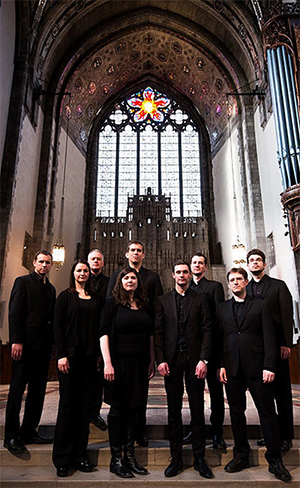by Daniel Hathaway

In a telephone conversation from Rochester, NY, where Anderson teaches musicology at the Eastman School of Music, the conductor noted that his singers have already performed the program in Chicago in 2016. “It’s been curated by Erika Honisch, a professor at SUNY Stony Brook, and is based on research that is soon to be released as a book.”
Anderson said that part of the mission of Schola Antiqua is to explore the canon of early vocal music, but also to draw on recent research and “to package programs under themes.” The Prague program, for example, seeks to serve up a slice of musical life in that important capital of the Holy Roman Empire around the year 1600. “We’re trying to show a whole landscape of music from high court art to local church music and hymns from the streets — covering all levels of society.”
The conductor noted that he enjoys letting his scholarly colleagues design some of the ensemble’s programs because they often introduce him to unfamiliar repertoire. “I didn’t know 60% of the music on the Prague program, which features both popular and insular composers.”
The former group includes motets by Jacobus Gallus (aka Jacob Handl), a local church musician who wrote more than 500 pieces in the genre. The concert will include his well-known Ecce quomodo moritur, “probably the most striking work on the program, with no fancy composing, just as direct as you can be,” as well as a pair of “Latin madrigals” honoring music and the glory of singing that end the evening. “I’d never encountered a Latin madrigal before,” Anderson said.
Orlandus Lassus is a well-known Renaissance figure, but Kryštof Harant and Carl Luython are among the more obscure local composers to be featured. One famous name in Renaissance music that comes as a surprise in a Prague-based program is that of English composer William Byrd.
“Philippe de Monte wrote Super flumina Babylonis, an 8-voice motet that somehow found its way to England. Monte may have exchanged music with Byrd, who seems to have responded with Quomodo cantabimus, an 8-voice piece on the same text that poignantly reflects the feelings of English Catholics, who found themselves — like the Babylonian Jews — exiled in a strange land.”

After the ensemble had expanded its repertoire, Anderson took the reins of the Schola in 2008, but from his new post at the Eastman School. The ensemble gives several programs each year in Chicago, and undertakes limited tours. The evolution of the group has included establishing partnerships with museums, including the Rochester Museum, the Art Institute of Chicago, and the Met in New York, where the Schola has added sonic components to exhibitions of Medieval Art.
Anderson himself has embarked on a study of Medieval books of hours, a subject the Schola previewed in 2012. “Those little devotional books were very popular in the 15th century. Many of them contained references to musical works but no musical notation. I’ve spent the last decade filling in the gaps for art historians — bringing the often separate disciplines of art and music history together.”
The conductor hopes to be able to include a visual component in its Cleveland program, depending on technical arrangements. “The music doesn’t need enhancement, but it’s always nice to see some period art along with the music.”
Published on ClevelandClassical.com February 19, 2020.
Click here for a printable copy of this article



